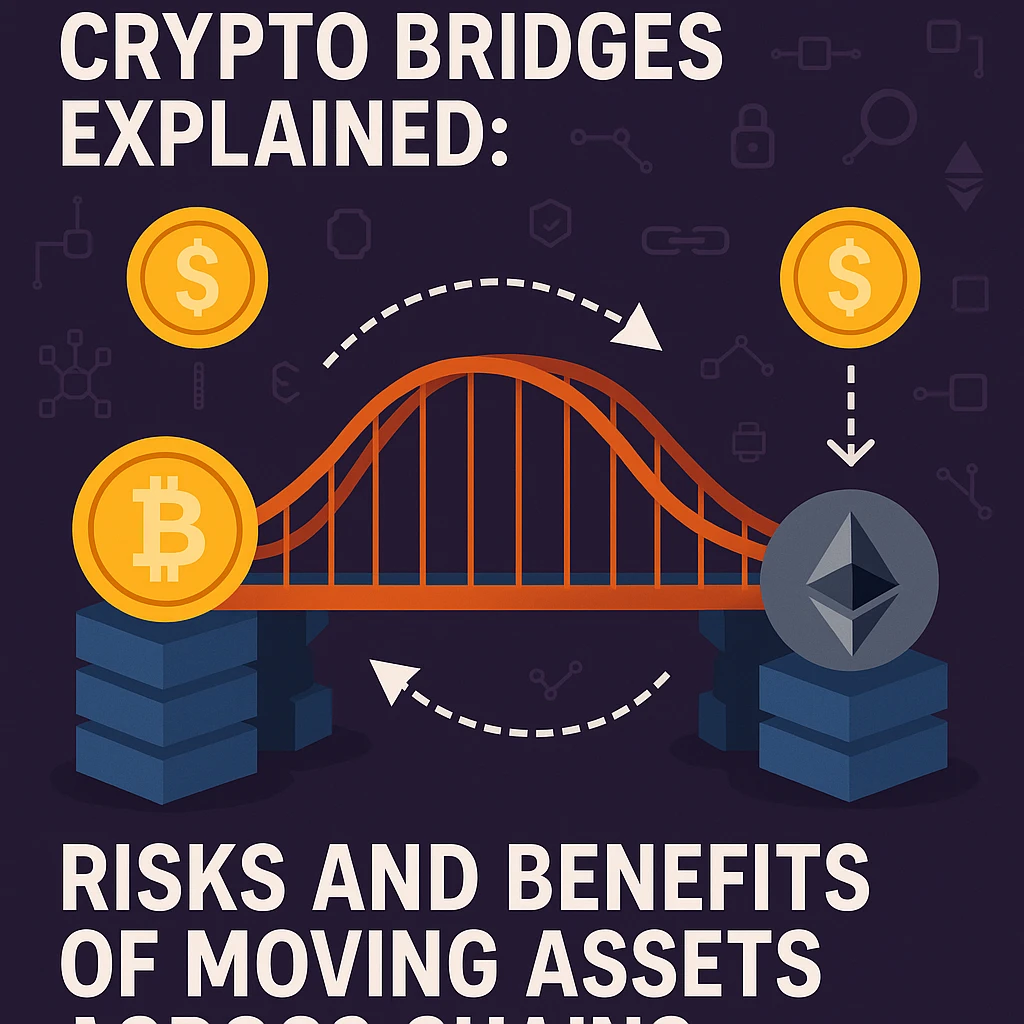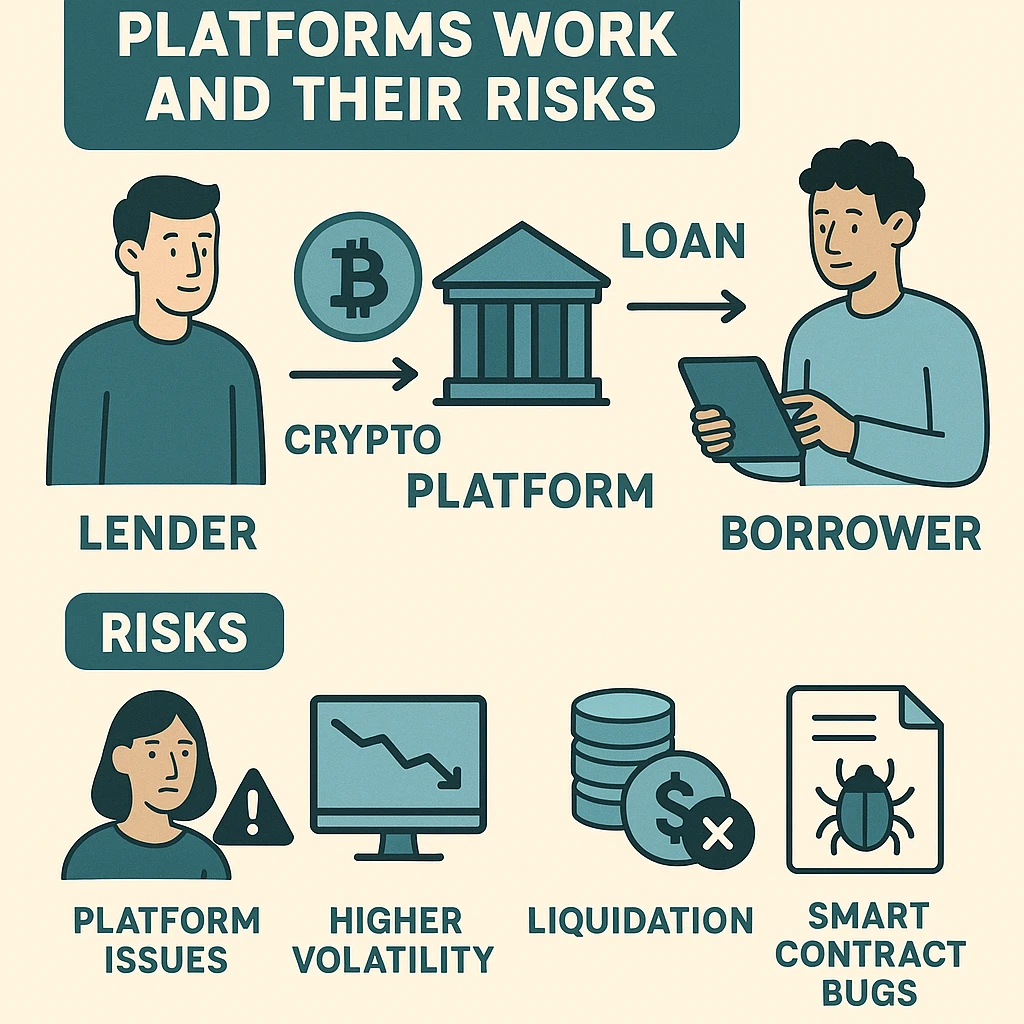There is no longer isolation in the blockchain space. Moving assets and data across the many Layer 1 blockchains, such as Ethereum, Binance Smart Chain, Avalanche, Solana, and others, has never been more important. Crypto bridges are useful in this situation. The problem of blockchain interoperability is being resolved by these cross-chain mechanisms, but they also present new risks and vulnerabilities.
This blog will discuss the definition of crypto bridges, their operation, their main advantages, potential drawbacks, and how bridging will develop within the crypto ecosystem in the future.
What Are Crypto Bridges?
A crypto bridge protocol facilitates the exchange of data and digital assets between two distinct blockchain networks. Bridges serve as a connection layer that enables users to transfer tokens between chains because blockchains are by nature isolated and unable to speak with one another directly.
You may wish to transfer Ethereum to the Avalanche network, for instance. A bridge has the ability to issue wrapped ETH (wETH) on Avalanche and lock the ETH on Ethereum. The original ETH is released on Ethereum and the wETH is burned on Avalanche when the user wishes to transfer the money back.
Based on their design and purpose, bridges come in a variety of forms. However, the fundamental goal of all bridges is to enable cross-chain compatibility in a decentralized environment.
How Do Crypto Bridges Work?
Crypto bridges use various mechanisms, but the two most common are:
Lock and Mint
In this method:
-
A user locks tokens into a smart contract on the source chain.
-
The bridge mints a wrapped version of the token on the destination chain.
-
When tokens are returned, the wrapped asset is burned, and the original is unlocked.
This is the most widely used method and powers many bridges such as Multichain and Wormhole.
Liquidity Pool-Based Bridges
Both blockchains' liquidity pools are necessary for these bridges to function. The bridge uses liquidity providers to enable a token swap rather than locking and minting. Imagine it as a cross-chain, decentralized exchange.
This method is often faster and doesn’t require wrapping assets, but it depends heavily on available liquidity.
Some bridges approve and verify cross-chain transactions using federated or hybrid models that involve trusted oracles or validators. There are trade-offs between speed, security, and decentralization in each strategy.
Benefits of Using Crypto Bridges
1. Interoperability
The smooth interoperability between blockchain ecosystems is the most evident benefit. Users can now use Ethereum-based tokens in the ecosystem of Solana or use Binance Smart Chain's BNB to take part in DeFi on Polygon. This maximizes asset utility and creates new opportunities.
2. Access to Lower Fees and Faster Transactions
In order to avoid the high gas fees on Ethereum, many users bridge assets to faster and less expensive Layer 1 or Layer 2 solutions. For example, moving stablecoins to Arbitrum or Avalanche enables faster, less costly transactions.
3. Yield Farming Across Chains
Bridges are frequently used by cryptocurrency investors who want to transfer tokens between ecosystems with the highest APRs in order to optimize yield farming opportunities. Capital efficiency is increased by this multichain farming.
4. NFT Portability
Additionally, NFT transfers between ecosystems are being facilitated by bridges. For less expensive trading and storage, an Ethereum-based NFT, for instance, could be transferred to a chain like Polygon.
5. Asset Diversification
Users can diversify their holdings across different blockchain ecosystems with the aid of bridging. This lessens exposure to the risks associated with any one chain, such as traffic jams or exorbitant fees.
6. Empowering dApps and Developers
Decentralized apps that run on several blockchains can be made by developers. This adaptability spurs creativity and expands the audience for dApps.
Risks of Using Crypto Bridges
Crypto bridges are one of the most exploited areas in the crypto industry, despite their usefulness. A number of well-publicized hacks have exposed the serious weaknesses in bridge infrastructure.
1. Smart Contract Exploits
Numerous bridges depend on intricate smart contracts, which may contain errors or weaknesses. Attackers can drain locked funds if they discover and take advantage of these vulnerabilities. For instance, errors in smart contract logic have cost several bridges hundreds of millions of dollars.
2. Centralization of Validators
Some bridges manage transfers using centralized systems or a limited number of validators. There is a greater chance of collusion or private key compromise if a small group controls bridge validation. This goes against the spirit of decentralization by creating a single point of failure.
3. Lack of Audits
Not every bridge is subjected to thorough third-party audits. Inadequate testing increases the likelihood of bugs, security lapses, and subpar performance in bridges. Unverified code can be very dangerous to trust.
4. Liquidity Issues
Inadequate liquidity in bridges can result in high slippage, transaction delays, or even transfer failure. For hours or days, users might discover that their money is in limbo.
5. Blockchain Finality Differences
The finality times of transactions vary among chains. Ethereum, for instance, completes blocks more quickly than certain Layer 1 chains. Timing-based attacks or transfer rollbacks may result from this discrepancy.
6. Oracle Manipulation
To confirm state changes across chains, some bridges rely on external oracles. Attackers can fraudulently mint or release tokens if oracles are compromised or manipulated.
7. Phishing and Scam Bridges
Fake bridge websites imitate well-known bridges in order to defraud users of their money. Even seasoned users are caught off guard by these increasingly realistic clone websites. Before connecting a wallet, make sure to check the official URL.
8. Regulatory Uncertainty
Bridging can lead to regulatory issues because it frequently entails transferring assets between jurisdictions. Cross-chain financial movements are still difficult for lawmakers to categorize or track, which may cause problems with compliance later on.
How to Use Crypto Bridges Safely
While no bridge is 100% safe, users can take steps to reduce their risk:
1. Use Reputable Bridges Only
Choose well-known, audited, and frequently used bridges that have been proven in battle. Synapse, Stargate, Multichain, and LayerZero-based bridges are a few examples.
2. Check for Audits
Always check if a bridge has been audited by a third party. If available, review the audit reports to see if any problems have been fixed.
3. Start with Small Transfers
To make sure a new bridge functions as intended, start with a small transfer. Avoid transferring a lot at once.
4. Use Hardware Wallets
Always use hardware wallets for high-value transfers to reduce the risk of malware or phishing attacks. Steer clear of social media bridge links.
5. Monitor Activity
When sending money through bridges, pay close attention to transaction explorers. Don't try again until you've determined what's causing your transaction to fail or become stuck.
6. Follow the Community
Use the bridge's official Twitter account or Discord to stay informed about the most recent security announcements and disclosures. Active community reporting has helped mitigate some bridge hacks in real time.
The Future of Crypto Bridges
Although there are many obstacles facing the bridge generation of today, the future is promising. The following advancements have the potential to change the area:
1. Composable Bridges
In order to directly integrate with DeFi protocols, next-generation bridges are becoming more modular. This makes it possible for cross-chain transactions to be automated, trustless, and more seamless.
2. Native Interoperability
The goal of projects like Polkadot (with parachains) and Cosmos (with IBC) is to make interoperability native, completely eliminating the need for external bridges.
3. Zero-Knowledge Proofs for Bridging
Zero-knowledge proofs are being tested by some experimental bridges to confirm cross-chain transfers without relying on middlemen. Numerous present security threats might be eliminated as a result.
4. Increased Decentralization
In order to penalize bad actors, more bridges are implementing decentralized validator models with slashing and staking. This may lessen the risks associated with centralization.
5. Insurance for Bridging
Bridge transactions may soon be protected by DeFi insurance protocols. In the event of hacks or stuck funds, users would be eligible for compensation.
Conclusion
Blockchain interoperability in the future depends on crypto bridges. They open up a multichain environment where users can freely exchange assets, engage with various ecosystems, and take advantage of each chain's advantages. But they also carry significant risks to trust, liquidity, and security.
We should anticipate safer, quicker, and more effective bridges that maximize flexibility while lowering user risk as technology advances. For now, the best way to benefit from cross-chain cryptocurrency without becoming a victim of its risks is to be informed and exercise caution.




Leave a Reply